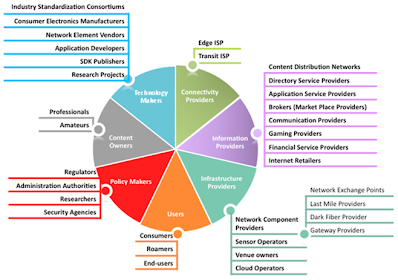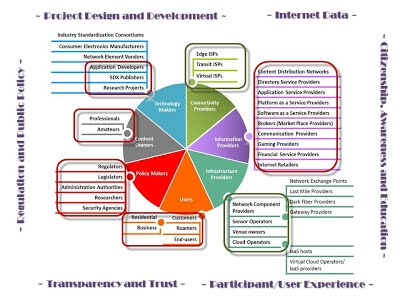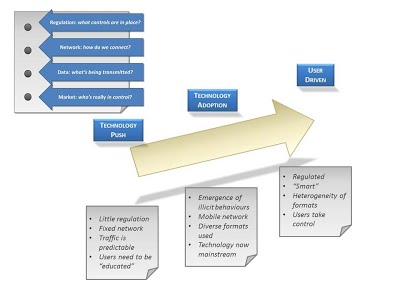Future Internet Socio Economics (FISE) is a complex and tangled
subject that itself is often a matter for debate. Internet means many things to
many people, the Future Internet we will always be working towards and Socio-Economics
is an umbrella term that includes a wealth of intangibles, opinions, and often disagreements.
As such, FISE experiences many ambiguities, lacks clarity, deals with equality
plausible interpretations of truth with people, issues and forces regularly pulling
in opposite directions. The topics in the coversation change with time but often continue to remain
ambiguous (e.g. privacy).
FISE utilises uncertainty as the fertile ground of creativity. Stepping into the unknown embraces a world of possibilities allowing businesses to create new revenue streams, for individuals and society to realise ambitions and for technologists to innovate. Without uncertainty and the unknown, life becomes regressive and a stale repetition of outworn ideas. FISE attempts to navigate the world of ambiguity, discover new perspectives on Future Internet research and in this section we will help you get started.
FISE is a subject with many experts but few who have comprehensive knowledge. Getting started is a matter of starting point so whether you are a technologist, economist, social scientist, policy maker or general enthusiast it is important to navigate from a point of knowledge. Over the next few months, in addition to regular posts on the three SESERV channels, we will build up maps through the FISE conversation bridging the perspectives of those who study and those who build the Future Internet. 1) SESERV ChannelsThe SESERV channels contain posts related to those who study, those who build and importantly the FISE conversation that aims to bridge the two communities.
2) The Future Internet Ecosystem and Socio-Economic Priorities
In 2009, the Internet Society defined an Internet
Ecosystem. The stakeholders originated from a traditional infrastructure
perspective, with the main portion of the supporting document describing the
responsibilities of the various standardisation bodies involved in what they
refer to as Open Standards Development and Naming and Addressing with freely
accessible processes for Policy Development. However, in recent years, the rapid
convergence of technologies has increased the scope of stakeholder engagement
with the Internet way beyond what was originally envisaged and described by the
Internet Society. A number of different models have been proposed for who the stakeholders might be within a Future Internet ecosystem and this is constantly being re-evaluated. SESERV has defined a possible FI ecosystem in the diagram opposite. This provides a classification of stakeholders whose dynamic characteristics will be explored in more detail during year 2 of the project. We see in this new model a significant increase in the diversity or roles, an increased emphasis on users in addition to previous infrastructure and a blurring of roles between major market players. The concerns of the Internet have moved from structures purely targeting transit and delivery of data to socio-economic structures supporting exchange of information and knowledge according to the values of individuals and communities. The SESERV coordination activities from Sept-10 until Aug-11 have identified key socio-economic priorities for the Future Internet ecosystem. The summary of the priorites provides a good starting point to understand the nature of discussions and concerns within the community.
3) Talking to stakeholders about the Future Internet Over the course of the SESERV project, as described in the various workshops (in Oxford, primarily centred around societal issues, Athens, with more of a network-economic approach, and then in Brussels, bringing it all together and looking very much to the future), we engaged with the many of the Future Internet stakeholders bringing them into the FISE Conversation and mapping out their views as they discussed in the various SESERV focus groups and the debates and panel sessions at the workshops. In the figure to the right, we can highlight the primary groups that we have spoken to (green is covered more fully in D2.2, and the red boxes those in D3.2 as well). And we've been able to highlight recommendations across six main thematic areas:
These are the areas that really need more attention (recommendations are outlined in D3.2 passim). Although there is some overlap with instruments such as the Digital Agenda for Europe and Horizon 2020, it really is time to put the focus on the end-users, their experience, and what they are doing on-line. This involves all areas, and as illustrated in both Athens and Brussels by network operators and ISPs, their expectation of a given level of Quality of Experience (QoE) rather than the operators' focus on Quality of Service (QoS) is posing significant challenges to the infrastructure itself. What we have found is that the technology and its use has really moved on. In the past, it was the technologists, those building the Future Internet (FI), who were in the driving seat. But now, the technology having been adopted and used far beyond its original purpose, it is the end-users who are in control: they are driving innovation, in a world where it is the non-PC devices which are opening up new opportunities, even for areas that would once have been regarded as "geeky" or "low-brow". This move from technology push, via adoption, to a user-driven context, has implications for those who would
All of this creates both challenges, as well as opportunities for the stakeholders in the Future Internet, which may be summarised as follows:
In bringing together all relevant stakeholders, the SESERV project has been able to highlight the main themes and concerns of all involved which will inform how the Future Internet needs to be shaped, what challenges it faces, along with the opportunities it affords. Looking to and involving end-users has to be the way forward: their involvement is key since failing to understand what they do makes network configuration almost impossible; and failing to understand their expectations and behaviours means that regulation and controls simply frustrate.
|
|
|




